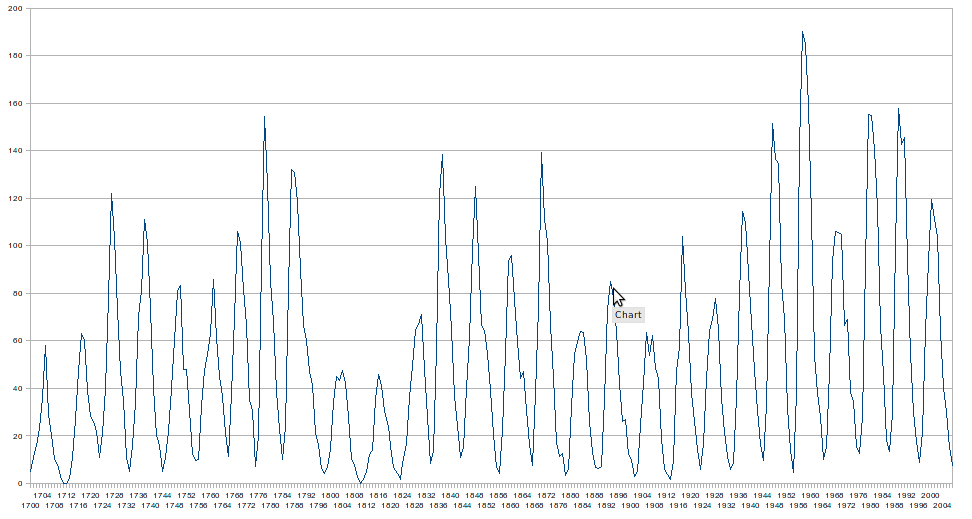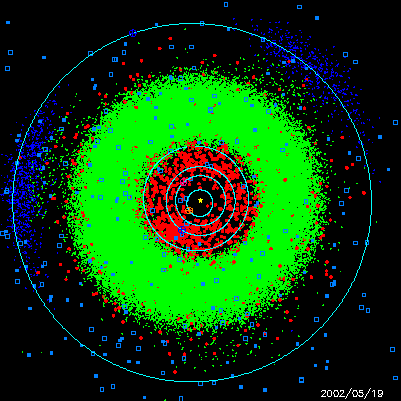Tagged “space”
-
The Gleissberg cycle
Looking at a graph of sunspot data, I independently discovered the well-known Gleissberg Cycle, a 78 year cycle of sunspots.
If you look at the following graph, you can easily spot the 11 year cycle of sunspots. However, if you look more distantly, you can also spot the longer Gleissberg cycle, with lows in the 1800s and 1900s, and highs in the 1850s and 1950s.

I was a bit sad to find that I had discovered something that was already known. An interesting discovery, nevertheless.
If you want to play with the numbers and plots, here is the source of the data I used to generate the plots.
-
Tropospheric ducting -- again
This is actually a cut and paste (mostly) of a previous entry I had exactly one year ago today! Strange how these atmospheric conditions manifested themself on exactly the same day.
This morning on the way to work, I received WOMC, a Detroit radio station broadcasting on 104.3 Mhz from a tower near Ferndale, Michigan, according to the Wikipedia entry. It was an extremely clear signal, and I listened to it for a half an hour until I arrived at my destination, and the signal never faded. Every so often, Erie receives good broadcasts from Detroit without interference. In fact, it was a better signal strength than most of the local stations.
-
Life on Europa?
This blog describes that the evidence for life on Europa, the moon of Jupiter, is mounting.
-
Tropospheric ducting
This morning on the way to work, I received WOMC, a Detroit radio station broadcasting on 104.3 Mhz from a tower near Ferndale, Michigan, according to the Wikipedia entry. It was an extremely clear signal, and I listened to it for a half an hour until I arrived at my destination, and the signal began fading. Every so often, Erie receives good broadcasts from Detroit without interference. In fact, it was a better signal strength than most of the local stations.
-
Kosmos 2251 debris observation
I went outside to try to spot the debris field of the Kosmos 2251 satellite, the one which recently hit the Iridium 33 satellite. I was able to see it (at a fairly bright magnitude), but spotted only one object, not a cluster of objects, as I had hoped.
-
List of Co-orbital Satellites
As you probably know, the Earth has only one natural orbiting body, the moon. However, you may not know that the Earth has several co-orbiting bodies - objects, most asteroids, which share the orbit of the Earth with the Earth and sometimes even enter into orbit around the Earth for periods of time. I could not find a nice comprehensive list on the internet, so here is my go at it. You can search deeper for more detailed explanation of each body.
-
J002E3 (Artificial, probably the lost S-IVB 3rd stage from Apollo 12)
-
2003 YN107
-
2004 GU9
-
2001 GO2
-
10563 Izhdubar
-
(66063)1998 RO1
-
(85990)1999 JV6
-
Cosmic shooting gallery

Animations of the planets around the sun, including all the various known comets and asteroids, can be found at this web page. It's quite unnerving to see how many different bodies come close to the earth as it goes around the sun.
-
Megatsnuami hit Madagascar
According to this report, scientists are examining an area of Madagascar near Faux Cap for evidence that a megatsunami, a giant wave likely caused by an asteroid or comet impact, struct the area several thousand years ago. Using Google Earth, I found what appeared to be shore dunelike traces in that area that extend 20 miles in the northwest direction.
Note also the number of white indentations that point in the same direction.
Unfortunately, the picture was lost.
-
The European Space Administration is Asleep
The European Space Administration is not paying attention. According to this article at the BBC:
A supposed asteroid, which it was feared was going to have a near-miss with Earth next week, has been identified as a spacecraft.
Professor Alan Fitzsimmons of Queen's University Astrophysics Research Centre told the BBC there is "no longer any need for concern".
"The 'asteroid' has been identified as the European spacecraft Rosetta," he said.
According to the Rosetta Home page, the spacecraft was launched March 2, 2004. How can you forget about a spacecraft after only 3 years?
See all tags.
